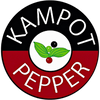Red pepper is Cambodia's sweet flagship – only a few countries in the world can grow it. Why? The harvesting process is extremely demanding and the climatic conditions for the grain's ripening must be perfect – this combination is provided only by the Kampot region in Cambodia, which is renowned for its true red pepper.
On one farm, you can produce maybe only a cup of red pepper per day
It is therefore extremely rare. Red Kampot pepper is harvested at full ripeness of the berry, which is usually at the end of the season in April/May, when the berry ripens in the sun for several months before it is completely red and full of juicy fructose. Unlike black pepper, it is not harvested along the entire stem, but farmers carefully monitor when some of the berries on the stem ripen to their orange-red color and at that moment they pick – this one single berry.
Thanks to its long ripening, this pepper is moister and juicier than all the others, but at the same time it is the most susceptible to cultivation. It also attracts small birds with its color, which gladly peck at it, so every protected berry is very precious. After harvesting, red pepper is boiled in hot water, then soaked in cold water and dried in the shade.
The cherry-red berries are incredibly sweet and fruity; the first flavors you notice are forest fruits, apples, rose, cherry, and rosehip. At first, it doesn't burn, but after one minute this spiciest of peppers unfolds and literally creates a pepper explosion in your mouth. It is said to be the most aromatic pepper in the world.
Only from true red pepper can genuine white pepper be obtained
It is its kernel that is obtained by soaking red pepper in water and peeling off the skin. Common white peppers in stores are incorrectly obtained by peeling black pepper, which is unripe and becomes musty after peeling.
Beware of fake peppers
Pink pepper, commonly available in spice blends, is nicely colored but grows on the branches of Brazilian pepper tree, so it is just a poor relative of true pepper. The same goes for cayenne pepper, whose name arose from a mistranslation; it is actually ground chili peppers. The red pepper you have known so far is therefore not true red pepper at all and has completely different flavor properties. Read more about these fake peppers in our article.
But what to expect from red pepper in the kitchen
This pepper is the flavor opposite of black pepper. Do not put it on meat – it pairs only with fish or seafood; on the contrary, as the king of cold cuisine, you will love it in combination with vegan and vegetarian dishes, salads, vegetables, eggs, vegetable soups, risotto, sweet desserts, and cocktails. In Czech cuisine, it is a popular spice for Christmas baking – incidentally, the Czech word for gingerbread (perník) is originally derived from pepper, which used to be an integral part of it!













